This is the third report on the wood structure of Nepal Himalayan woody plants. The first part of this series was published in Himalayan Plants, Volume 1, pp. 341-397; 1988 (ed. by H. Ohba and S.B. Malla), and the second part was in the Himalayan Plants, Volume 2, pp. 17-65; 1991 (ed. by H. Ohba and S.B. Malla). We describe here the wood structure of 55 species in five families: Celastraceae (10 species), Araliaceae (10), Ericaceae (17), Ulmaceae (6) and Fagaceae (12). All species of the Ericaceae described here are in the genus Rhododendron and are different from the species described in the first part,where 12 were described.
We made ten sets of microscopic slides for each wood sample. The microscopic slides of the first and the second parts are deposited in the following institute or laboratories: National Herbarium and Plant Laboratories, Department of Forestry and Plant Research, Nepal, Kathmandu; Department of Botany, the University Museum, University of Tokyo, Tokyo; Forestry and Forest Products Research Institute, Tsukuba; Wood Research Institute, Kyoto University; Rijksherbarium, Leiden; Royal Botanic Gardens, Kew; Forest Products Laboratory, U.S. Department of Agriculture, Madison and Department of Biology, Faculty of Science, Tohoku University, Sendai. Microscopic slides used in this volume will be deposited in the same laboratories and in the Hyogo Prefec-tural Museum of Human and Nature, Sanda. Voucher specimens will be deposited in the herbaria: the Department of Forestry and Plant Research (KATH), Nepal, Kathmandu; Department of Botany, the University Museum, University of Tokyo (TI), Tokyo, and Department of Biology, Faculty of Science, Tohoku University (TUS), Sendai. Although microscopic slides and voucher specimens were previously deposited in the Department of Biology, College of Liberal Arts, Kanazawa University, Kanazawa, all of those specimens were moved to the Department of Biology, Faculty of Science, Tohoku University (TUS), Sendai, on April 1, 1994.
We are grateful to Dr. S.B. Malla and Dr. S.B. Rajbhandary, Department of Forestry and Plant Research, Kathmandu, and Dr. Hideaki Ohba, the University of Tokyo, for their help and hospitality in the course of this study. Thanks are also due Dr. Takashi Yamazaki, the University of Tokyo and Dr. K.R. Rajbhandari for their identification of voucher specimens.
This study was partly supported by the following Grants-in-Aid for International Scientific Research (Field Research) by the Ministry of Education, Science, Sports and Culture, Japan: Nos.58041022 in 1983 and 60041018 in 1985 to Dr. Hideaki Ohba, the University of Tokyo; Nos.63041060 in 1988, 03041035 in 1991 and 1992, 06041043 in 1994 and 1995, and 09041143 in 1997 and 1998 to MS.
Asterisked specimens are those on which the descriptions and microscopic photographs are mainly based on.
For the convenience of description, diameters of pores, in which the vessel walls are included, are expressed as the radial measurements always come first followed by tangential measurements; for the diameter of pits, vertical measurements first followed by horizontal measurements; for the diameter of ray cells, vertical measurements always come first followed by tangential and radial measurements.
CELASTRACEAE (Kazuo TERADA and Mitsuo SUZUKI)
Celastrus stylosus Wall. [Plate 49]

Deciduous vines in the temperate zone.
SPECIMENS. No. 8340291*, d=6 cm, alt. 2810 m: Gandaki Zone, Manang Distr., Bardang (2850m) - Chame (2630 m), H. Ohba et al., Aug. 5, 1983. No. 8540126, d=2.5 cm, alt. 2320 m: Bagmati Zone, Nuwakot Distr., Kutumsang (2450 m) - Gul Bhanjyang (2120m), M. Suzuki & S. Noshiro, June 5, 1985. No. 9263127, d=6 cm, alt. 1420 m: Mechi Zone, Taplejung Distr., Chiruwa (1210 m) - Tapke Top (1320 m) - Leiep (Tamur bridge) (1460 m) - Thakpa Bazaar (1600 m), M. Suzuki et al., May 22, 1992. No. 9263218, d=4 cm, alt. 1970 m: Mechi Zone, Taplejung Distr., Amji Khola (2320 m) - Dupi Danda (2500 m) -Yamphudin (1680 m), S. Noshiro et al., June 13, 1992.
DESCRIPTION. Wood ring porous with one row of distinctly large pores at beginning of growth rings, or semi-ring porous with larger round pores in 1-3 rows in early wood and radially arranged small pores in late wood. Growth rings distinct, delineated by ring porosity and radially flattened fiber tracheids; 0.34-2.35 mm wide. Pores decreases from early to late wood rather abruptly. In early wood, large pores densely arranged; solitary or irregularly 2-4 multiple, round or a little radially elongated in outline, 160-280 (30-255 in No. 8540126) and 110-270 (30-240) µm in radial and tangential diameters respectively, very thick-walled (about 7 µm). In late wood small pores, dense, irregular, in radial multiples or in clusters; 7.5-17.5 µm in diameter.
Vessel elements, end walls almost horizontal in large pores, 70-280 µm long; rather oblique in small pores, 215-285 µm long; perforation plates exclusively simple. Intervessel pits, in large pores opposite, round to polygonal in outline, about 7.5 µm in diameter with horizontally elongated slit-like apertures; in small pores alternate, dense, polygonal in outline, about 7.5 µm in diameter with slit-like apertures. Spiral thickenings present, especially conspicuous on the entire inner wall of late wood vessel elements. Tylose and gum-like deposits absent.
Imperforate tracheary elements fiber tracheids and vascular tracheids; rectangular, square or polygonal in cross section, 10-25µm in diameter, with thick-walled (about 3 µm). Bordered pits circular, about 5 µm in diameter. Spiral thickenings distinct.
Wood parenchyma scanty paratracheal or diffuse; triangular, square to polygonal in cross section; in strands, cells 5-20 µm in diameter, 15-75 µm long; crystals absent.
Rays heterogeneous, uniseriate and multiseriate, occupying 1 l-37(average 24.5)% of horizontal length in tangential section. Uniseriate rays consisting of upright or square cells, 1-17 cells and 40-450 µm or more tall. Multiseriate rays large and tall, fusiform, 40-250 µm wide, 0.5-1.5 mm or more tall; consisting of procumbent, upright or square cells. Ray vessel pits alternate, dense, about 7 µm in diameter with slit-like or horizontally elongated apertures. Crystals abundant in multiseriate ray cells.
Euonymus amygdalifolius Franch. [Plate 50]
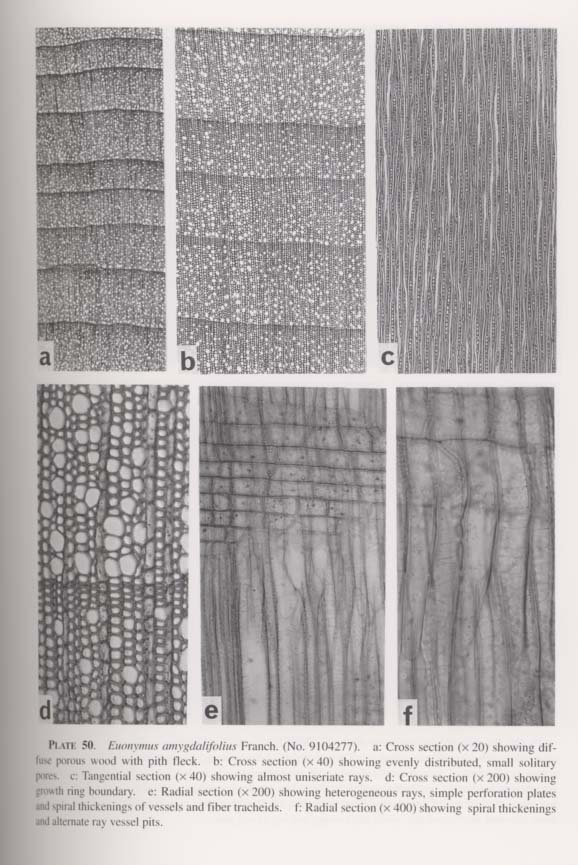
Deciduous small trees in the subalpine zone.
SPECIMEN. No. 9104277*, d=5 cm, h=3 m, alt. 3100 m: Karnali Zone, Dolpa Distr., Camp site (3100 m) - Quadrat #6 (Pinus-Quercus; 3100 m) - Churta Khora (3520 m) - Mauria Lagma (3920 m) - Camp site (3500 m), M. Minaki et al., Sept. 28, 1991.
DESCRIPTION. Wood diffuse porous with very small pores. Growth rings distinct, delineated by radially flattened fiber tracheids at end of growth rings, narrow, 0.29-0.65 mm wide. Discontinuous rings and false rings absent. Pores evenly distributed, tending to be more abundant at beginning of growth rings, numerous, 448-528/mm2; almost solitary, radially elongated polygonal or round in outline; pores size minute, 12.5-35 and 12.5-27.5µm in radial and tangential diameters respectively, thin-walled (about 1-2 µm). Pith flecks occasionally present.
Vessel elements 300-600 µm long; end walls oblique, perforation plates exclusively simple. Intervessel pits inconspicuous, very rare, sparse, round in outline, about 6.5-7.5 µm in diameter with slit-like apertures. Spiral thickenings distinct. Tylose and gumlike deposits absent.
Imperforate tracheary elements fiber tracheids and septate fibers constituting ground mass of wood, rectangular, square or polygonal in cross section, 6-17.5 µm in diameter, rather thick walled (about 3 µm). Fiber tracheids with distinct bordered pits, circular, about 6.5µm in diameter, with oblique slit-like apertures (about 0.8 µm); spiral thickenings distinct. Septate fibers with minute slit-like pits (about 1.5 µm); spiral thickenings not so distinct.
Wood parenchyma inconspicuous, rare, scanty paratracheal or diffuse, quite difficult to recognize in cross section because it very similar to imperforate tracheary elements or small pores, triangular, square to polygonal in cross section, in strands, 5-15 µm in diameter; spiral thickenings and crystals absent.
Rays heterogeneous, almost uniseriate or sometimes 2-seriate, 12-19 rays/mm in tangential section. Rays consisting of procumbent, upright or square cells, 1-22(-32) cells and 35-520(-840) µm tall. Procumbent cells round or vertically elliptic in tangential section, 17.5-30, 10-22.5 × 35-110 µm. Upright or square cells elliptic or oblong in tangential section, 30-70, 7.5-20 × 20-60 µm. Ray vessel pits numerous and alternate, round or slightly elliptic, about 3 É m in diameter. Gum-like deposits not so distinct. Crystals sometimes observed in ray cells.
Euonymus echinatus Wall. [Plate 51 ]
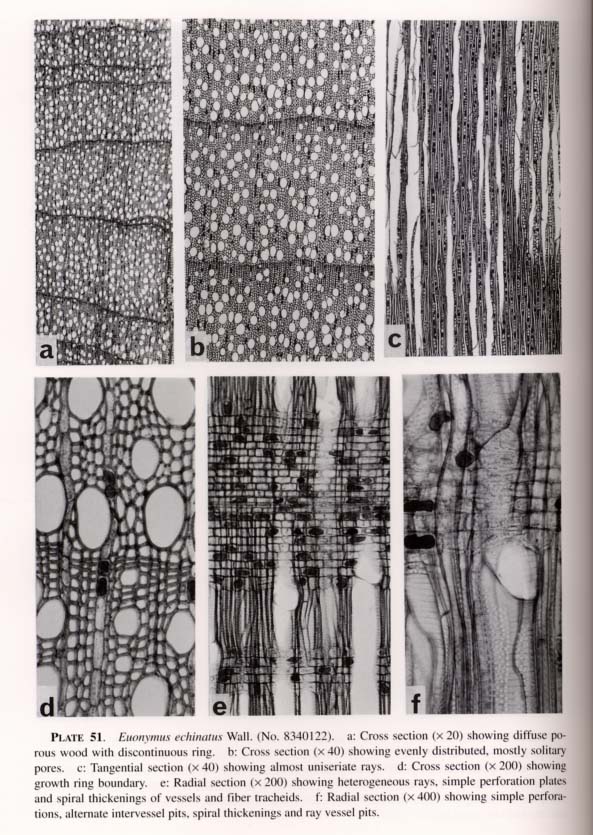
Evergreen vines in the temperate zone.
SPECIMENS. No. 8340122*, d=8 cm, alt. 2600 m: Gandaki Zone, Kaski Distr., Bhainsi Kharaka (2460 m) -Banthanti (2600 m), H. Ohba et al., July 11, 1983. No. 8840179, d=1 cm, alt. 2320 m: Koshi Zone, Sakuwasabha Distr., around Tashi Gaon (2160 m), M. Suzuki et al., July 13, 1988. No. 8840595, d=2.5 cm, alt. 2360 m: Gandaki Zone, Myagdi Distr., Ghodepani Deurali (2830 m) - Tirkhedhunga (1540 m), M. Suzuki et al., Sept. 6, 1988. No. 8840447, d=4 cm, alt. 2560m: Gandaki Zone, Kaski Distr., Bhainsi Kharka (2460 m) - Banthanti (2600 m), M. Suzuki et al., Aug 23, 1988.
DESCRIPTION. Wood diffuse porous with medium size pores and conspicuous compound rays. Growth rings distinct, discontinuous rings often present, delineated by
radially flattened fiber tracheids at end of growth rings, variable, 0.15-1.1 mm wide. Pores evenly distributed, tending to be few at end of growth rings, 136-162/mm2; almost solitary, radially elongated elliptic or round in outline; pore size somewhat reduced gradually form beginning to end of the growth rings, (12.5-)17.5-117.5(17.5-77.5 in No. 8840447) and (12.5-)17.5-62.5(17.5-65) µm in radial and tangential diameters respectively, thin-walled (about 2 µm). Pith flecks sometimes observed.
Vessel elements 500-900 µm long; end walls rather oblique; perforation plates exclusively simple. Intervessel pits inconspicuous, rare, round in outline, about 5-7 µm in diameter, with slit-like apertures. Spiral thickenings distinct. Tyiose and gum-like deposits absent.
Imperforate tracheary elements fiber tracheids constituting ground mass of wood, rectangular, square or polygonal in cross section, 7-25 µm in diameter, thick-walled (about 2.5 µm). Bordered pits circular, about 5 µm in diameter, with oblique slit-like apertures. Spiral thickenings distinct. Septate fibers not so distinct.
Wood parenchyma scanty paratracheal or diffuse; triangular, square to polygonal in cross section, in strands of 2-4 cells, 7-20 µm in diameter, 65-250 µm long; spiral thickenings and crystals absent.
Rays heterogeneous, uniseriate or often 2-seriate, sometimes conspicuously large compound to aggregate rays. 1-2-seriate rays, 12-17 rays/mm in tangential section; consisting of procumbent, upright or square cells, 40-600 µm or more tall. Procumbent cells round or vertically elliptic in tangential section, 12.5-20, 7.5-16 × 25-80 µm. Upright or square cells elliptic or oblong in tangential section, 30-65, 8-20 × 25-45 É m. Compound to aggregate rays irregular fusiform in outline, consisting of procumbent, upright or square cells, 3-10 cells and 750-1250 µm or more tall. Ray vessel pits with distinct borders, similar to intervessel pits, alternate, dense, round or slightly elliptic, about 5-8 µm in diameter. Gum-like deposits abundant. Crystals sometimes observed in ray cells.
Euonymus fimbriatus Wall. [Plate 52]
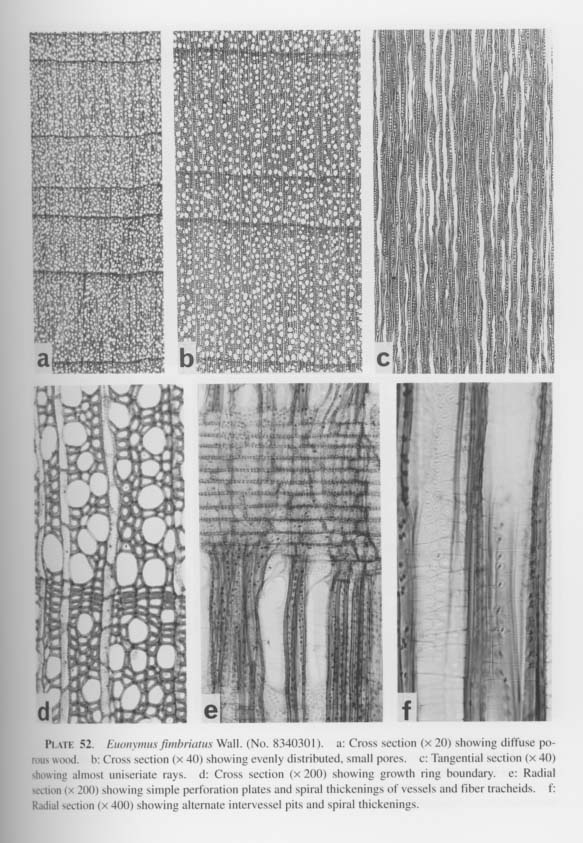
Deciduous small trees in the upper temperate and subalpine zones.
SPECIMENS. No. 8340301*, d=20 cm, h=6 m, alt. 2750 m: Gandaki Zone, Manang Distr., Bardang (2850 m) - Chame (2630 m), H. Ohba et al., Aug. 5, 1983. No. 9104384, d=25 cm, h=5 m, alt. 3450 m: Kamali Zone, Dolpa Distr., Daja (3620 m) -quadrat #8 (Juniperus; 3620 m) - Pugmi[Pamgma] (3250 m) - Sumduwa (3100 m) - Camp site (3100 m), M. Minaki et al., Oct. 5, 1991. No. 9194258, d=5 cm, h=4.5 m, alt. 2950 m: Seti Zone, Bajura Distr., Khaptad National Park (2980 m) - Gate (2280 m) - Kaudegaon (1900 m), M. Suzuki et al., Aug 28, 1991. No. 9194261, d=7.5 cm, h=3 m, alt. 2850 m: Seti Zone, Bajura Distr., Khaptad National Park (2980 m) - Gate (2280 m) - Kaudegaon (1900 m). M, Suzuki et al., Aug 28, 1991.
DESCRIPTION. Wood diffuse porous with numerous small pores. Growth rings distinct; delineated by radially flattened fiber tracheids at end of growth rings, 0.08-1.03 (0.76-3.03 in No. 9104384) mm wide. Discontinuous rings often found, but absent in No. 9104384. Pores evenly distributed, tending to be more abundant at beginning of growth rings, 404-540/mm2; solitary and 2-4 multiple, radially elongated polygonal or round in outline, 12.5-50 and 12.5-40 µm in radial and tangential diameters respectively, thin-walled (about 1.5 µm). Pith flecks absent.
Vessel elements 200-770 µm long; end walls oblique; perforation plates exclusively simple. Intervessel pits not so conspicuous, rare, round or polygonal in outline, about 5-7.5 µm in diameter, with slit-like apertures (about 1.5 µm). Spiral thickenings distinct. Tylose and gum-like deposits absent.
Imperforate tracheary elements fiber tracheids; constituting ground mass of wood, rectangular, square or polygonal in cross section, 5-20 µm in diameter, thick-walled (about 2.5-3 µm). Bordered pits circular, 5-6 µm. in diameter, with oblique slit-like apertures. Spiral thickenings distinct. Septate fibers not so distinct.
Wood parenchyma inconspicuous, diffuse; quite difficult to recognize in cross section because it very similar to that of fiber tracheids, triangular, square to polygonal in cross section, in strands of 2-4 cells, 8.5-20 µm in diameter; spiral thickenings and crystals absent.
Rays nearly homogeneous, almost uniseriate or sometimes 2-seriate, 14-18 rays/mm in tangential section. Uniseriate rays consisting of procumbent, upright or square cells, 1-30(-48) cells and 150-620(-840) µm tall. Procumbent cells round or vertically elliptic in tangential section, 12.5-25, 6.3-20 × 17.5-120 µm. Upright or square cells elliptic or oblong in tangential section, 27.5-60, 15-17.5 × 25-42.5 µm. Ray vessel pits numerous and alternate, round or slightly elliptic, about 3-4 µm in diameter. Gum-like deposits absent. Crystals sometimes observed in ray cells.
Euonymus frigidus Wall. [Plate 53]
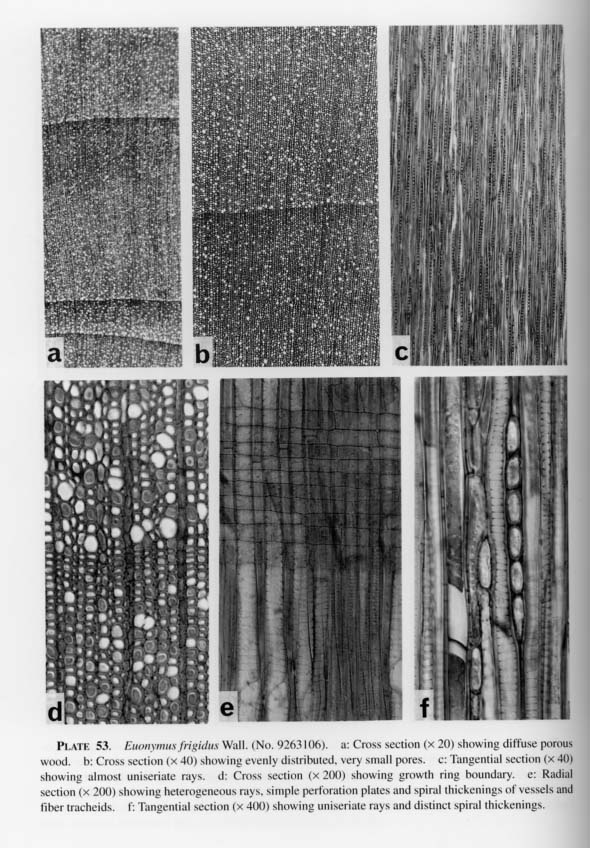
Evergreen shrubs in the temperate zone.
SPECIMEN. No. 9263106*, d=4 cm, h=1.5 m, alt. 2250 m: Mechi Zone, Taplejung Distr., Sewaden (2490 m) - Dongen (2260 m) - Papung (1940 m), M. Suzuki et al., May 18, 1992.
DESCRIPTION. Wood diffuse porous with very small pores. Growth rings somewhat distinct, delineated by radially flattened fiber tracheids at end of growth rings, discontinuous rings sometimes present, 0.4-2.15 mm wide. Pores evenly distributed, numerous, with 1 row of somewhat large pores gathered at the initiation of growth rings, almost solitary, square or polygonal in cross section, minute, 6.5-30 and 8.5-25 µm in radial and tangential diameters respectively, thin-walled (about 1 µm). Pore size reduced gradually from the beginning to end of growth rings (to distinguish small pores from fiber tracheids and wood parenchyma very difficult because of their similar size). Pith flecks absent.
Vessel elements 475-850 µm long; end walls rather oblique; perforation plates exclusively simple. Intervessel pits rarely observed, sparse, round in outline, 5-7 µm in diameter with slit-like apertures. Spiral thickenings distinct. Tylose and gum-like deposits absent.
Imperforate tracheary elements septate fibers and fiber tracheids, rectangular, square or polygonal in cross section. Septate fibers distinct, 8-25 µm in diameter, rather thinwalled (1.5-2 µm), with minute slit-like pits, spiral thickenings absent. Fiber tracheids 6-20 µm in diameter, thick-walled (2.5-3 µm), with distinct bordered pits, circular, about 5 µm in diameter; spiral thickenings distinct.
Wood parenchyma diffuse, rare, triangular, square to polygonal in cross section,
about 10µm in diameter; spiral thickenings and crystals absent.
Rays heterogeneous, almost uniseriate or sometimes 2-seriate, 8-14 rays/mm in tan-gential section. Uniseriate rays consisting of procumbent, upright or square cells, 1-40 cells and 60-850 µm or more tall. Procumbent cells round or vertically elliptic in tan-gential section, 12.5-35, 5-17.5 × 25-100 µm. Upright or square cells elliptic or ob-long in tangential section, 30-65, 10-15 × 15-40 ×m. Ray vessel pits numerous and alternate, round or slightly elliptic, about 3 ×m in diameter. Gum-like deposits absent. Crystals sometimes observed in ray cells.
Euonymus pendulus Wall. [Plate 54]
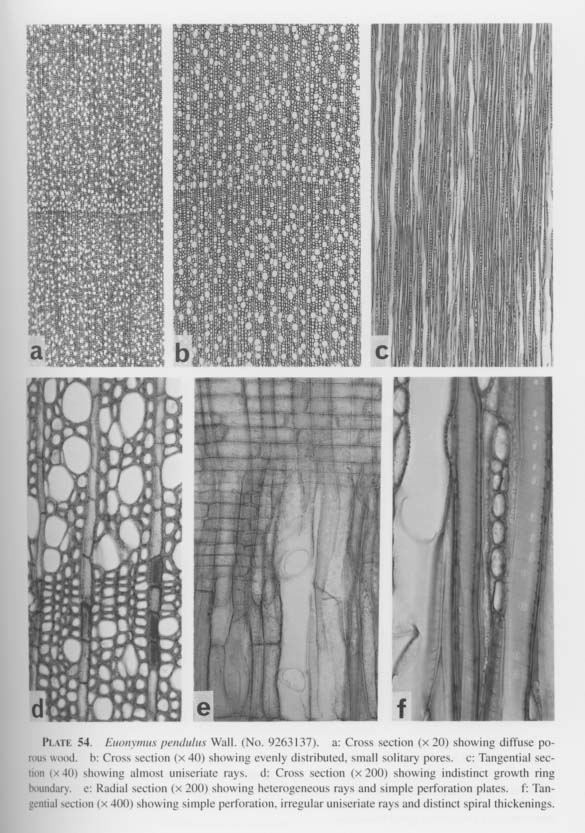
Deciduous trees in the temperate zone.
SPECIMENS. No. 8340331, d=50 cm, h=15 m, alt. 2300 m: Gandaki Zone, Manang Distr., Chame (2630m)-Thangjo (2580m), H. Ohba et al., Aug. 6, 1983. No. 9263137*, d=20 cm, h=7 m, alt. 2170m: Mechi Zone, Taplejung Distr., Thakpa Bazaar (1600 m)-Suketar (Tamur bridge) (2020 m)-Ramsyang Pati (2310 m), M. Suzuki et al., May 23, 1992.
DESCRIPTION. Wood diffuse porous with small pores. Growth rings not distinct, about 5mm wide. Discontinuous rings and false rings absent in No. 9263135, but fre-quent in No. 8340331. Pores evenly distributed, 165-210/mm2, almost solitary, po-lygonal in outline, 22.5-70 and 12.5-40µm in radial and tangential diameters respec-tively, thin-walled(about 2-4 µm). Pith flecks not found.
Vessel elements 300-550µm long; end walls rather oblique; perforation plates ex-clusively simple. Intervessel pits rarely observed, opposite, sparse, polygonal or round in outline, about 4-5µm in diameter with slit-like apertures. Spiral thickenings present, but not so conspicuous. Tylose and gum-like deposits absent.
Imperforate tracheary elements fiber tracheids and septate fibers, rectangular, square to polygonal in cross section, 12.5-35 µm in diameter, thick-walled (about 3 µm). Bor-dered pits circular, about 4µm in diameter. Spiral thickenings distinct. Septate fibers not so distinct; spiral thickenings absent.
Wood parenchyma rather conspicuous, scanty paratracheal, triangular, square to po-lygonal in cross section, in strands of 2-5 cells, 5-22.5 µm in diameter. Spiral thickenings and crystals absent.
Rays heterogeneous, almost uniseriate or sometimes 2-seriate, 13-17 rays/mm in tangential section. Rays consisting of procumbent, upright or square cells, 1-27(-37) cells and 20-630(-850) µm. Procumbent cells round or vertically elliptic in tangential section, 7.5-30, 6.3-17.5× 27-187.5 µm. Upright or square cells elliptic or oblong in tangential section, 27.5-77.5, 8-15 × 25-47.5 µm. Ray vessel pits numerous and alter-nate, round or slightly elliptic, about 3-4 µm in diameter. Gum-like deposits often observed. Crystals sometimes observed in ray cells.
Euonymus porphyreus Loes. [Plate 55]

Deciduous shrubs in the upper temperate and subalpine zones.
SPECIMENS. No. 8840226, d=4 cm, h=1.2 m, alt. 2940 m: Koshi Zone, Sakuwasabha Distr., Danda Kharaka (2860 m) - Unshisa Kharaka (3150 m) - Khongma (3500 m), M. Suzuki et al., July 15, 1988. No. 9263073*, d=5 cm, h=4 m, alt. 2920m: Mechi Zone, Taplejung Distr., Sewaden (2490 m)- a bridge (2760 m)-a kharka (3120 m)- Topke Gola (3590 m), M. Suzuki et al., May 15, 1992.
DESCRIPTION. Wood diffuse porous or sometimes with a tendency of semi-ring po-rous with very small pores. Growth rings distinct, delineated by radially flattened fiber tracheids at end of growth rings or porosity at beginning of growth rings, 0.1-1.36 mm wide. Discontinuous rings or false rings absent in No. 9263073, but frequent in No. 8840226. Pith flecks sometimes found. Pores abundant at beginning of growth rings, scarce at end of growth rings, almost solitary, polygonal or round in outline; pore size somewhat gradually reduced from the beginning to the end of growth rings, 12.5-35 and 12.5-27.5 µm in radial and tangential diameters respectively, thin-walled (about 1 µm).
Vessel elements 350-900 µm long; end walls oblique, perforation plates exclusively simple. Intervessel pits, rarely observed, round in outline, about 5.8 µm in diameter with nearly horizontal slit-like apertures. Spiral thickenings distinct. Tylose and gum-like deposits absent.
Imperforate tracheary elements fiber tracheids and septate fibers, constituting ground mass of wood, imperforate tracheary elements, small pores and wood parenchyma quite similar size and difficult to distinguish; triangular, rectangular, square or polygonal in cross section, 5-17 µm in diameter, thick-walled (about 3µm). Fiber tracheids with distinct bordered pits, circular, about 5 µm in diameter; spiral thickenings distinct. Septate fibers with, sparse, minutely slit-like pits; spiral thickenings absent.
Wood parenchyma inconspicuous, diffuse, very similar to imperforate tracheary ele-ments, quite difficult to recognize in cross section; square to polygonal in cross section, cells 5-17.5 µm in diameter. Crystals absent.
Rays heterogeneous, almost uniseriate or sometimes 2-seriate, 11-14 (7-13 in No. 8840226) rays/mm in tangential section. Rays consisting of procumbent, upright or square cells, 1-30 cells and 50-600 µm. Procumbent cells round or vertically elliptic in tangential section, 10-27.5, 5-16 × 32.5-150µm. Upright or square cells elliptic or oblong in tangential section, 22.5-90, 6.3-17.5× 15-37.5µm. Ray vessel pits alter-nate, dense, round or slightly elliptic, about 4-6.5 µm in diameter. Gum-like deposits often observed. Crystals sometimes observed in ray cells.
Euonymus sanguinea Loes. ex Diels [Plate 56]
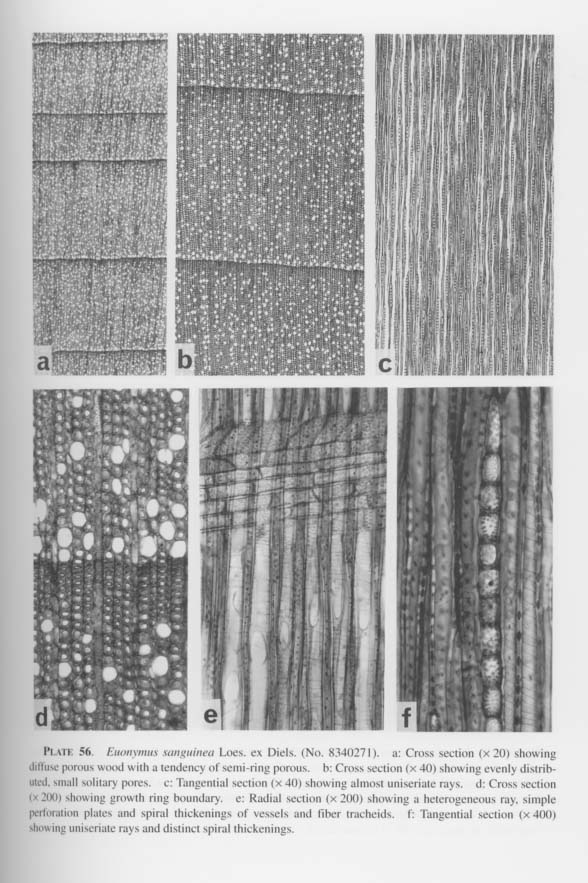
Deciduous shrubs in the subalpine zone.
SPECIMEN. No. 8340271*, d=4 cm, h=3 m, alt. 3200m: Gandaki Zone, Manang Distr., Humde (3320 m) -Pisang (3130 m), H. Ohba et al., Aug. 4, 1983.
DESCRIPTION. Wood diffuse porous with very small pores. Growth rings distinct, delineated by radially flattened fiber tracheids at end of growth rings, discontinuous rings often present, variable, 0.09-1.12 mm wide. False rings scarcely present, Pith flecks absent. Pores evenly distributed, tending to be gathered in 1-row of the initial of growth ring, 440-500/mm2, almost solitary, square to polygonal or round in outline, 8.8-30 and 7.5-30µm in radial and tangential diameters respectively, thin-walled (about 0.5 µm).
Vessel elements 500-1000 µm long; end walls rather oblique; perforation plates ex-clusively simple. Intervessel pits rarely observed, alternate, polygonal or round in out
line, about 5 µm in diameter with slightly elongated slit-like apertures. Spiral thickenings present. Tylose and gum-like deposits absent.
Imperforate tracheary elements fiber tracheids and septate fibers, rectangular, square or polygonal in cross section, 5-20 µm in diameter, thick-walled (about 2.5 µm). Fiber tracheids with distinct bordered pits, circular, about 5 µm in diameter; spiral thickenings distinct. Septate fibers sometimes present; spiral thickenings absent.
Wood parenchyma inconspicuous, rare, diffuse or scanty paratracheal, quite difficult to recognize in cross section because of similarity to imperforate tracheary elements, triangular, square to polygonal in cross section, cells 6-12 µm in diameter; crystals absent.
Rays heterogeneous, almost uniseriate or scarcely 2-seriate, 8-16 rays/mm in tan-gential section. Rays consisting of almost procumbent, sometimes upright or square cells, 1-25 cells and 30-560 µm. Procumbent cells round or vertically elliptic in tan-gential section, 17.5-22.5, 10-17.5× 30-110 µm. Upright or square cells elliptic or oblong in tangential section, 25-55, 10-17.5 × 17.5-40 µm. Ray vessel pits alternate, slightly elliptic, about 3 µm in diameter. Gum-like deposits absent. Crystals sometimes observed in ray cells.
Euonymus tingens Wall. [Plate 57]
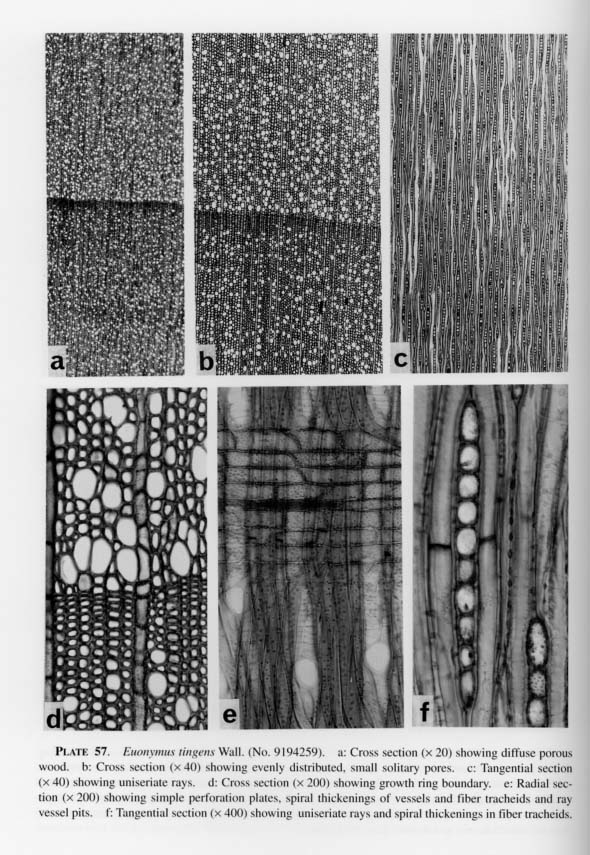
Evergreen small trees in the upper temperate and subalpine zones.
SPECIMENS. No. 8340012, d=8 cm, alt. 2750 m: Bagmati Zone, Kathmandu Valley, Mt. Pulchoke, H. Ohba et al., June 30, 1983. No. 8340021, d= -cm, alt. 2710m: Bagmati Zone, Kathmandu Valley, Mt. Pulchoke, H. Ohba et al., June 30, 1983. No. 8340465, d=25 cm, h=7 m, alt. 2650 m: Janakpur Zone, Dolakha Distr., Kyalche (2700m)-Thandingma (3200m), H. Ohba et al., Sept. 1, 1983. No. 8540039, d=40 cm, h=9 m, alt. 2700 m: Bagmati Zone, Rasuwa Distr., Lama Hotel (2480 m)-Ghora Tabela (3000m), M. Suzuki & S. Noshiro, May 25, 1985. No. 9194087, d=38.5 cm, h=9 m, alt. 2780 m: Bheri Zone, Dailekh Distr., Panipokhari (2020 m)-Bajangeneta (2220 m)- Beuli (2440 m)- a pass (2880 m)- Chaukebada (2340 m), M. Suzuki et al., Aug. 4, 1991. No. 9194164, d=12cm, h=3.5 m, alt. 2600m: Seti Zone, Bajura Distr., Birseni (1560 m)-Shalkatiyan (1700 m)-Naulakot (1810 m)-Pirekot (1900m)- Pandusen (2020m)- Porakya Deorali (pass) (2650m)-Porakya (2540 m), M. Suzuki et al., Aug 12, 1991. No. 9194259*, d=17.5 cm, h=4.5 m, alt. 2970 m: Seti Zone, Bajura Distr., Khaptad National Park (2980 m)- Gate (2280 m)-Kaudegaon (1900 m), M. Suzuki et al., Aug 28, 1991.
DESCRIPTION. Wood diffuse porous with very small pores. Growth rings distinct, delineated by radially flattened fiber tracheids at end of growth rings, 2-4 (mean 0.64 in No. 8340021) mm wide. In No. 8340021 discontinuous rings and/or false rings often found. Pores evenly distributed, tending to be more abundant at beginning of growth rings, 272-396/mm2; almost solitary, polygonal or round in outline, 10-55 and 10-37.5 µm in radial and tangential diameters respectively thin-walled (about 1-1.5 µm).
Vessel elements 300-800 µm long; end walls rather oblique; perforation plates exclusively simple. Intervessel pits alternate, polygonal or round in outline, about 5-6 µm in diameter with slit-like apertures. Spiral thickenings present, very conspicuous because of thick spiral ridges on inner face of vessel elements.Tylose and gum-like deposits absent.
Imperforate tracheary elements fiber tracheids and septate fibers, rectangular, square or polygonal in cross section, 5-15µm in diameter, thick-walled (about 3µm). Fiber tracheids with distinct bordered pits, circular, 5-6.5 µm in diameter; spiral thickenings distinct. Septate fibers distinct, with rather many, small, slit-like pits; spiral thickenings not so distinct.
Wood parenchyma inconspicuous, scanty paratracheal or diffuse, quite difficult to recognize in cross section because of similarity to imperforate tracheary elements, tri-angular, square to polygonal in cross section, in strands of 2-4 cells, 5-15 µm in diam-eter, 50-160 µm long. Crystals absent.
Rays almost homogeneous, mostly uniseriate or sometimes 2-seriate, 11-18 (6-14 in No. 8340021) rays/mm in tangential section. Rays consisting of procumbent, upright or square cells, 1-33 cells and 15-670µm. Procumbent cells round or vertically elliptic in tangential section, 10-25, 8.8-20× 30-160 µm. Upright or square cells elliptic or oblong in tangential section, 27.5-87.5, 12.5-20 × 25-37.5µm. Ray vessel pits alter-nate, dense, round or slightly elliptic, about 4-5µm in diameter. Gum-like deposits often observed. Crystals sometimes observed in ray cells.
Maytenus rufa (Wall.) H. Hara [Plate 58]

Evergreen small trees in the lower temperate zone.
SPECIMENS.No. 8340359, d=30 cm, h=7 m, alt. 1580 m: Gandaki Zone, Lamjung Distr., Tal (1620 m)-Jagat (1300 m), H. Ohba et al., Aug. 8, 1983. No. 9194195*, d=12.9 cm, h=5 m, alt. 1320 m: Seti Zone, Bajura Distr., Serigaon (1690m) -Ukhadi (1630 m) -a river (1370 m)- Jugalo (1430 m)-a pass (1600 m)-Budhiganga Khora (bridge) (1400 m)- Bashala (1760 m), M. Suzuki et al., Aug 14, 1991.
DESCRIPTION. Wood diffuse porous with small pores and parenchyma-like fiber bands alternating with ordinary fibers. Growth rings rather indistinct, delineated by radially flattened fiber tracheids at end of growth rings, 0.5-2 mm wide. False rings sometimes present. Pores evenly distributed, tending to be more abundant at beginning of growth rings, 80-120 ( 91-128 in No. 8340359)/mm2; almost solitary, polygonal or round in outline, 15-75 and 20-60 µm in radial and tangential diameters respectively, rather thick-walled(about 2.5-3 µm).
Vessel elements 100-500 µm long; end walls rather oblique; perforation plates ex-clusively simple. Intervessel pits alternate, round in outline, about 3µm in diameter, with slit-like apertures. Spiral thickenings absent. Tylose and gum-like deposits absent.
Imperforate tracheary elements fiber tracheids and fibers, tangential bands of rela-tively thin-walled fibers alternating with bands of thicker-walled fiber tracheids. Fiber tracheids rectangular, square or polygonal in cross section, 5-22 µm in diameter, thick-walled (3-4µm), with distinct bordered pits, circular, about 4 µm in diameter. Fibers rather large, 7-25µm in diameter, rather thin-walled (about 2µm). Spiral thickenings absent.
Wood parenchyma scanty paratracheal, triangular, square to polygonal in cross section, in strands, cells 5-15µm in diameter with thin-walled (about 2µm); Spiral thick-enings and crystals absent.
Rays heterogeneous, almost 1-3-seriate, irregular fusiform in outline, 13-20 rays/
mm in tangential section. Rays consisting of almost upright or square and sometimes procumbent cells, 50-190 (65-70 in No. 8340359) µm tall and 15-44 (30-40 in No. 8340359) É m wide. Procumbent cells round or vertically elliptic in tangential section,15-25, 7.5-15 × 30-75 µm. Upright or square cells elliptic or oblong in tan-gential section, 30-50, 7.5-20 × 12-32.5 µm. Ray vessel pits numerous and alternate, very small, irregularly round in outline, about 1.5-2.5 µm in diameter. Gum-like de-posits often observed. Crystals abundant in ray cells.
ARALIACEAE (Kiyotsugu Yoda and Mitsuo Suzuki)
Acanthopanax cissifolius (Griff. ex Seem.) Harms [Plate 59]

Deciduous shrubs in the temperate and subalpine zones.
SPECIMENS. No. 8340137, d=8 cm, h=3 m, alt. 2760 m: Dhawalagiri Zone, Myagdi Distr., Deolari (3050 m) -Ghodepani Deorali (2830 m), H. Ohba et al., July 12, 1983. No. 8840477, d=3 cm, h=1.6m, alt. 3150m: Gandaki Zone, Kaski Distr., Banthanti (2600m)-Ghodepani Deurali (3050 m), M. Suzuki et al., Aug. 24, 1988. No. 8840590, d=4 cm, h=1.5 m, alt. 2640m: Gandaki Zone, Myagdi Distr., Ghodepani Deurali (2830 m)- Tirkhedhunga (1540 m), M. Suzuki et al., Sept. 6, 1988. No. 9263089*, d=4 cm, h=3 m. alt. 3050 m: Mechi Zone, Taplejung Distr., Topke Gola (3590 m)-Sewaden (2490 m), M. Suzuki et al., May 17, 1993.
DESCRIPTION. Wood diffuse porous with small slightly polygonal pores in a single horizontal row at beginning of growth rings, pores linearly arranged or in clusters, pore clusters in oblique wavey pattern, pore size reduced gradually from beginning to end of growth rings. Growth rings distinct by mean of pore diameter and flattened marginal fiber tracheids define growth ring boundaries, usually narrow, 0.1-1.8 mm. Pores abun-dant, 87-145/mm2, mainly obliquely and occasionally radially or tangentially aligned with two to many pores in late wood, occasionally solitary; pores slightly polygonal in outline, small, 40-90 × 30-70 µm at beginning of growth rings, very small, 20-55 × 20-55 µm in late wood, thin walled (about 2 µm).
Vessel elements of medium, 400-640µm; perforation plates exclusively simple. Intervessel pits on both radial and tangential walls, moderately spaced and opposite or slightly alternate, round, about 8µm in diameter, with elliptic to slit-like apertures. Spiral thickenings absent.
Non-perforated tracheal elements fiber tracheids, sometimes septate. Fiber tracheids constituting ground mass of wood, polygonal in cross section, 8-28 µm in diameter, with thick walls (about 2.5 µm). Bordered pits on both radial and tangential walls moderately spaced, small and round, about 3 µm in diameter, with slit-like apertures. Spiral thickenings absent.
Wood parenchyma scanty paratracheal, very little in early wood and sparse in late wood. Crystals absent.
Rays heterogeneous, uniseriate and multiseriate, occupying 20.0-30.0 (average 25.0)% of horizontal length in tangential section. Uniseriate rays consisting of square to up-right cells, 1-9 cells and 55-540µm tall. Multiseriate rays moderately wide and tall fusiform in tangential section, consisting mainly of procumbent cells with square or upright cells at periphery of multiseriate bodies, often with uniseriate wings made up of 1-6 cells, 80-280 µm tall at the upper and lower ends of multiseriate bodies, 2-9 cells and 30-150µm wide, and 190-3240 µm tall. Procumbent cells round or slightly polygonal in tangential section, 15-25, 10-25 × 55-105µm; square or upright cells elliptic or oblong in tangential section, 30-70, 10-25 × 25-40 µm. Ray vessel pits large, moderately spaced and slightly opposite, elliptic or occasionally horizontally elongated, with window-like apertures, 5-25 µm in diameter. Crystals absent.
Brassaiopsis aculeata (Buch.-Ham. ex D.Don) Seem. [Plate 60]

Deciduous small trees in the temperate zone.
SPECIMENS. No. 8540098, d=6 cm, h=3 m, alt. 1880m: Bagmati Zone, Rasuwa Distr., Lama Hotel (2480 m) -Syabru (2240 m), M. Suzuki & S. Noshiro, May 30, 1985. No. 8840495*, d=8 cm, h=3.2 m, alt. 1980m: Gandaki Zone, Myagdi Distr., Ghodepani Deurali (2830 m)-Shika (2010 m), M. Suzuki et al., Aug 25, 1988.
DESCRIPTION. Wood diffuse porous with sparsely distributed round or polygonal pores in irregular clusters; pore size reduced gradually from beginning to end of growth rings. Growth rings in distinct by mean of pore diameter and flattened marginal fiber tracheids define growth ring boundaries, usually wide, 1.0-6.0 mm. Pores sparse, 5-23/mm2, evenly distributed except at beginning of growth rings, solitary or in radial multiples, occasionally in irregular clusters; multiples or clusters consisting of two to four (five) pores. Solitary pores round or slightly polygonal in outline, medium to small, 55-160 × 60-120µm in early wood, 60-100 × 60-90 µm in late wood, thin walled (about 2 µm).
Vessel elements long, 590-1050 µm; perforation plates simple or scalariform with two to five bars. Intervessel pits on both radial and tangential walls, opposite to scalari-form, round, elliptic or horizontally elongated in outline, 10-95 µm in diameter. Spiral thickenings absent.
Non-perforated tracheal elements fiber tracheids, sometimes septate. Fiber tracheids constituting ground mass of wood, polygonal in cross section, 15-45µm in diameter, with thick walls (about 3µm). Bordered pits on both radial and tangential walls, mod-erately spaced, small and round, about 2 µm in diameter, with slit-like apertures. Spiral thickenings absent.
Wood parenchyma scanty paratracheal and very sporadic. Crystals absent.
Rays heterogeneous, uniseriate and multiseriate, occupying 14.0-35.0 (average 26.4) % of horizontal length in tangential section. Uniseriate rays consisting of square and upright cells, 1-12 cells and 13-99µm tall. Multiseriate rays moderate to wide and low fusiform in tangential section, consisting of procumbent, square and upright cells, irregular in size in tangential section; square or upright cells arranged at periphery of multiseriate bodies like sheath cells; 2-10 cells and 40-180 µm wide, 325-1850 µm tall. Procumbent cells round to elliptic in tangential section, 20-40, 10-30 × 60-185 µm; square or upright cells elliptic or oblong in tangential section, 55-155, 10-35 × 40-70 µm. Ray vessel pits opposite to scalariform, elliptic to horizontally elongate in out-line, with window-like apertures, 15-40µm in diameter. Crystals absent.
Brassaiopsis alpina C.B. Clarke [Plate 61]

Deciduous small trees in the upper temperate zone.
SPECIMENS. No. 9154083, d=15 cm, h=4.5 m, alt. 2910 m: Koshi Zone, Sankhuwa
Sabha Distr., Gupha Pokhari (2800 m)-Angare Kharka (2930 m), H. Ohba et al., July 17, 1991. No. 9263100*, d=9 cm, h=7 m, alt. 2310m: Mechi Zone, Taplejung Distr., Sewaden (2490 m)- Dongen (2260 m)- Papung (1940 m), M. Suzuki et al., May 18, 1993. No. 8840229, d=22 cm, h=8 m, alt. 3060 m: Koshi Zone, Sakuwasabha Distr., Danda Kharaka (2860 m)- Unshisa Kharaka (3150 m)- Khongma (3500 m), M. Suzuki et al., July 15, 1988.
DESCRIPTION. Wood diffuse porous with small round to elliptic or polygonal pores in irregular clusters; pore size reduced gradually from beginning to end of growth rings, often tending to be semi-ring porous with slightly larger pores at beginning of growth rings, pore clusters in discontinuous wavey pattern. Growth rings distinct by mean of pore diameter and flattened marginal fiber tracheids define growth ring bound-aries, usually narrow, 0.25-1.4 mm. Pores sparse to abundant, 36-128/mm2, horizon-tally aligned or in clusters of two to about 20 pores at beginning of growth rings, and in oblique, tangential or radial multiples or in clusters in late wood, occasionally solitary; pores elliptic or polygonal in outline, small to medium, 40-130 × 35-80 µm in early wood and 25-55 × 25-50 µm in late wood, thin walled (about 2 ×m).
Vessel elements moderate in length, 420-860×m; perforation plates mostly simple and occasionally scalariform with a few bars. Intervessel pits on both radial and tan-gential walls, scalariform to opposite and occasionally alternate, round, elliptic or hori-zontally elongated in outline, 7-25×m in diameter, with slit-like to horizontally elon-gated apertures. Spiral thickenings absent.
Non-perforated tracheal elements fiber tracheids, sometimes septate. Fiber tracheids constituting ground mass of wood, polygonal in cross section, 8-28µm in diameter, with thick walls (about 3 µm). Bordered pits moderately spaced on radial walls and sparse on tangential walls, tiny and round, about 2µm in diameter, with slit-like aper-tures. Spiral thickenings absent.
Wood parenchyma scanty paratracheal and sparse. Crystals absent.
Rays heterogeneous, uniseriate and multiseriate, occupying 14.0-23.0 (average 16.4) % of horizontal length in tangential section. Uniseriate rays consisting of square to procumbent and upright cells, 1-8 cells and 40-380µm tall. Multiseriate rays me-dium to narrow and low fusiform in tangential section, mostly made up of procumbent cells with square or upright cells at the periphery, upper and lower ends of multiseriate bodies occasionally with uniseriate wings 2-6 cells tall, 2-6 cells and 20-80 µm wide, and 120-2610µm tall. Procumbent cells round to elliptic in tangential section, 15-25, 7-20 × 65-200×m; square or upright cells elliptic or oblong in tangential section, 35-125, 10-20× 25-35 µm. Ray vessel pits round, elliptic or horizontally elongated, with wide apertures, 8-28µm in diameter. Crystals absent.












